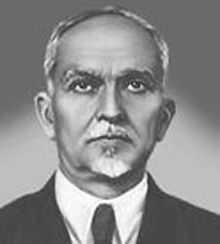Nikolai Cholodny
| Nikolai Grigoryevich Cholodny | |
|---|---|
 | |
| Born |
22 June 1882 Tambov, Russian Empire |
| Died |
4 May 1953 (aged 70) Kiev, USSR |
| Nationality | USSR |
| Occupation | Microbiologist |
| Known for | Cholodny–Went model |
Nikolai Grigoryevich Cholodny (Russian: Никола́й Григо́рьевич Холо́дный ; 22 June 1882 – 4 May 1953) was an influential microbiologist who worked at the University of Kiev, Ukraine in the USSR during the 1930s.
He is known for the Cholodny–Went model, which he developed independently with Frits Warmolt Went of the California Institute of Technology. Despite being associated with the same theory, the two men never actually met.[1]
Cholodny worked in the A.V. Fomin Botanical Garden, attached to the University of Kiev.[2] He was one of the pioneers of the concept that microbes adhere to surfaces, using the technique of first placing glass slides in earth for a measured time period, then using a microscope to examine the slides.[3][4] The Prokaryote Leptothrix cholodnii is named after him.[5] In 1927 Cholodny proposed that the cells of the coleoptile are first polarized under the influence of uneven exposure to light, so growth hormone can diffuse more rapidly towards the side in the shade than in any other direction.[6] Went reached the same conclusion in 1928, and the two scientists' names have been attached to the controversial Cholodny-Went theory.[7]
Bibliography
Selected works include:[8]
- 1926 Die eisenbakterien : bieträge zu einer monographie by N Cholodny
- 1928 Über eine vermeintliche Anomalie im Wachstumsmodus der Wurzeln von Lupinus albus by N Cholodny
- 1932 Lichtwachstumsreaktion und Phototropismus 2 by N Cholodny
- 1933 Zum Problem der Bildung und physiologischen Wirkung des Wuchshormons bei den Wurzeln by N Cholodny
- 1939 Spezielle Methoden.
In 1937 N. G. Cholodny and E. Ch. Sankewitsch published an article on INFLUENCE OF WEAK ELECTRIC CURRENTS UPON THE GROWTH OF THE COLEOPTILE in Plant Physiology.[9] The same year he published an article on CHARLES DARWIN AND THE MODERN THEORY OF TROPISMS in Science magazine.[10]
References
- ↑ F.W, Went (1974). "Reflections and Speculations". Annual Review of Plant Physiology. doi:10.1146/annurev.pp.25.060174.000245. Retrieved 2012-06-17.
- ↑ "About Botanical Garden". O.V. Fomin Botanical Garden. Retrieved 2012-06-17.
- ↑ Hilary M. Lappin-Scott (1999). "Claude E. Zobell – his life and contributions to biofilm microbiology". Proceedings of the 8th International Symposium on Microbial Ecology. Retrieved 2012-06-17.
- ↑ Jonas Långmark, Nicholas J Ashbolt, Ulrich Szewzyk, Thor Axel Stenström (2001). "Adequacy of in situ glass slides and direct sand extractions to assess the microbiota within sand columns used for drinking water treatment". Canadian Journal of Microbiology 47 (7). pp. 601–607. Retrieved 2012-06-17.
- ↑ J.P. Euzéby. "List of Prokaryotic names with Standing in Nomenclature - Genus Leptothrix". Retrieved 2012-06-17.
- ↑ "Le phototropisme • Chez les végétaux supérieurs". Encyclopædia Universalis France S.A. Retrieved 2012-06-17.
- ↑ Vladimir Orbovik and Kenneth I. Poff (1993). "Growth Distribution during Phototropism of Arabidopsis thaliana Seedlings". Plant Physiology 103 (1): 157–163. Retrieved 2012-06-17.
- ↑ "Cholodny, N.". Worldcat. Retrieved 2012-06-17.
- ↑ N. G. Cholodny and E. Ch. Sankewitsch (April 1937). "INFLUENCE OF WEAK ELECTRIC CURRENTS UPON THE GROWTH OF THE COLEOPTILE". Plant Physiology 12 (2): 385–408. doi:10.1104/pp.12.2.385. PMC 439299. PMID 16653418. Retrieved 2012-06-17.
- ↑ Cholodny (19 November 1937). "CHARLES DARWIN AND THE MODERN THEORY OF TROPISMS". Science 86 (2238): 468. doi:10.1126/science.86.2238.468. Retrieved 2012-06-17.